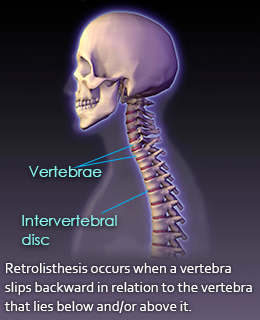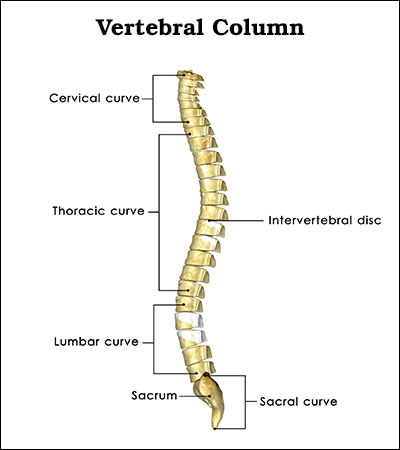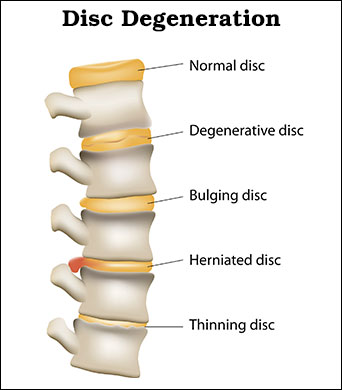Retrolisthesis and spondylolisthesis are degenerative conditions that are characterized by the backward and forward displacement of a vertebra in relation to the underlying vertebra, respectively. This Buzzle write-up provides information on the symptoms and causes of retrolisthesis.

Did You Know?Retrolisthesis is often considered to be less common and insignificant than spondylolisthesis. However, in a recent study involving 269 patients affected by degenerative spondylolisthesis, 106 patients were diagnosed with pure retrolisthesis, 130 patients had pure anterolisthesis, and 33 patients had combined retrolisthesis and anterolisthesis (anterior displacement of the vertebra with respect to adjacent vertebra). So, retrolisthesis might not be as rare as it is considered to be.Commonly referred to as the spine or the backbone, the S-shaped human vertebral column is composed of several bony segments that are stacked on one another. Basically, the vertebral column is composed of 24 articulating vertebrae (seven cervical vertebrae, twelve thoracic vertebrae, and five lumbar vertebrae), five vertebrae that fuse into one large bone called sacrum, and four coccygeal vertebrae that make up the tailbone. The articulating vertebrae are separated by intervertebral discs, but the sacral and coccygeal vertebrae are not separated by these discs. The number of articulating vertebrae remains the same, but there could be variations in case of coccygeal vertebrae. The tailbone is mostly made of four vertebrae, but some people might have 5 vertebrae. Each of these vertebra comprises a vertebral body, vertebral arch, vertebral foramen, lamina, pedicles, articular processes, and spinous processes.
Age is one of the factors that is linked with the degenerative changes in the spine. Retrolisthesis is one such condition that could be associated with degenerative changes. This condition is characterized by backward slippage of a vertebra in relation to the vertebra lying below and/or above it. The displacement of bone can be measured in millimeters to ascertain the degree of retrolisthesis.
Causes of Retrolisthesis

Retrolisthesis is the posterior displacement of the vertebra with respect to the underlying and/or overlying vertebra. It is classified into three types: complete, stairstepped, and partial. It is considered to be complete, when the body of one vertebra is posterior to the vertebral body of the overlying and underlying vertebra. In case of stairstepped retrolisthesis, the body of the vertebra slips backward in relation to the vertebra that lies above, but is anterior to the underlying vertebra. A person will be diagnosed with partial retrolisthesis, when the body of the vertebra has slipped backward in relation to either the overlying or the underlying vertebra.
The term 'intervertebral foramina' refers to openings located between adjacent vertebrae through which the spinal nerves exit. For the purposes of classifying retrolisthesis, the intervertebral foramina are divided from the anterior to posterior dimension into four equal parts.
✦ Grade 1 refers to the posterior displacement of up to ¼ of the intervertebral foramen
✦ Grade 2 refers to the posterior displacement from ¼ to ½ of the foramen
✦ Grade 3 refers to the posterior displacement of ½ to ¾ of the foramen
✦ Grade 4 refers to the posterior displacement of ¾ to total occlusion of the intervertebral foramen
Though the displacement mostly affects the cervical or lumbar vertebrae, the thoracic vertebrae could also be affected. More often than not, poor posture or repetitive stress injuries to the spine could be the reason behind the displacement. There are certain medical conditions that are linked to age-related degeneration of the spine. Osteoarthritis is one such condition that is characterized by the degeneration of the cartilage that lines the ends of the joints. With age, even the intervertebral discs that act like cushions or shock absorbers can shrink. This can lead to the displacement of the vertebrae.

Trauma to the vertebral column due to accidents or falls can cause the disc to bulge from its place. At times, the hard exterior of the disc (annulus) can crack, thereby causing the soft, jelly-like material (nucleus pulposus) to protrude out of the disc. If the bulging or herniated disc presses against the spinal canal or narrows the intervertebral foramen, the spinal nerves can get compressed, which in turn can lead to pain and other symptoms. At times, congenital defects or poor posture could be the contributing factors for this condition.
Symptoms
Subluxation due to trauma or degenerative changes could cause the vertebra to move more than 2 mm. The posterior displacement of the vertebra could cause the narrowing of the intervertebral foramen, through which nerves, veins, arteries, and lymphatic vessels pass. It could also cause protrusion or bulging of the soft tissue of the disc. The disc could become dry or herniate, as the hard exterior of the intervertebral disc ruptures. This can affect joint stability. A host of symptoms might be experienced under such circumstances. These include:
✦ Pain
✦ Weakness
✦ Numbness
✦ Tingling sensation
In case of cervical retrolisthesis, pain might be experienced in the neck. It might also radiate to the shoulders, arms, or fingers. Similarly, lumbar retrolisthesis could cause pain in the back, which might radiate to the lower extremities.
The treatment of this condition involves correcting the posterior displacement and realigning the affected vertebra. The surrounding soft tissues also need to be repaired or strengthened, so that they can provide support to the vertebra. Physical therapy can prove beneficial in such cases, as the physical therapist can chalk out an exercise regimen that involves exercises that stabilize the affected vertebra and improve the range of motion. Staying hydrated and following a diet that is rich in proteins, amino acids, copper, manganese, vitamin A, vitamin C, zinc, glucosamine, etc., will also prove beneficial. It is advisable to keep a tab on one's weight, so as to ensure that there isn't excess pressure on the spine. Microcurrent therapy, which involves the application of low-level electrical currents, might also help reduce inflammation and pain, and facilitate the regeneration of soft tissue. Surgery will be recommended in severe cases, where the conservative treatment options don't work. Surgery is more likely to be considered for spondylolisthesis than retrolisthesis.
Disclaimer:
The information provided in this article is solely for educating the reader. It is not intended to be a substitute for the advice of a medical expert.


 Did You Know?Retrolisthesis is often considered to be less common and insignificant than spondylolisthesis. However, in a recent study involving 269 patients affected by degenerative spondylolisthesis, 106 patients were diagnosed with pure retrolisthesis, 130 patients had pure anterolisthesis, and 33 patients had combined retrolisthesis and anterolisthesis (anterior displacement of the vertebra with respect to adjacent vertebra). So, retrolisthesis might not be as rare as it is considered to be.Commonly referred to as the spine or the backbone, the S-shaped human vertebral column is composed of several bony segments that are stacked on one another. Basically, the vertebral column is composed of 24 articulating vertebrae (seven cervical vertebrae, twelve thoracic vertebrae, and five lumbar vertebrae), five vertebrae that fuse into one large bone called sacrum, and four coccygeal vertebrae that make up the tailbone. The articulating vertebrae are separated by intervertebral discs, but the sacral and coccygeal vertebrae are not separated by these discs. The number of articulating vertebrae remains the same, but there could be variations in case of coccygeal vertebrae. The tailbone is mostly made of four vertebrae, but some people might have 5 vertebrae. Each of these vertebra comprises a vertebral body, vertebral arch, vertebral foramen, lamina, pedicles, articular processes, and spinous processes.
Did You Know?Retrolisthesis is often considered to be less common and insignificant than spondylolisthesis. However, in a recent study involving 269 patients affected by degenerative spondylolisthesis, 106 patients were diagnosed with pure retrolisthesis, 130 patients had pure anterolisthesis, and 33 patients had combined retrolisthesis and anterolisthesis (anterior displacement of the vertebra with respect to adjacent vertebra). So, retrolisthesis might not be as rare as it is considered to be.Commonly referred to as the spine or the backbone, the S-shaped human vertebral column is composed of several bony segments that are stacked on one another. Basically, the vertebral column is composed of 24 articulating vertebrae (seven cervical vertebrae, twelve thoracic vertebrae, and five lumbar vertebrae), five vertebrae that fuse into one large bone called sacrum, and four coccygeal vertebrae that make up the tailbone. The articulating vertebrae are separated by intervertebral discs, but the sacral and coccygeal vertebrae are not separated by these discs. The number of articulating vertebrae remains the same, but there could be variations in case of coccygeal vertebrae. The tailbone is mostly made of four vertebrae, but some people might have 5 vertebrae. Each of these vertebra comprises a vertebral body, vertebral arch, vertebral foramen, lamina, pedicles, articular processes, and spinous processes. Retrolisthesis is the posterior displacement of the vertebra with respect to the underlying and/or overlying vertebra. It is classified into three types: complete, stairstepped, and partial. It is considered to be complete, when the body of one vertebra is posterior to the vertebral body of the overlying and underlying vertebra. In case of stairstepped retrolisthesis, the body of the vertebra slips backward in relation to the vertebra that lies above, but is anterior to the underlying vertebra. A person will be diagnosed with partial retrolisthesis, when the body of the vertebra has slipped backward in relation to either the overlying or the underlying vertebra.
Retrolisthesis is the posterior displacement of the vertebra with respect to the underlying and/or overlying vertebra. It is classified into three types: complete, stairstepped, and partial. It is considered to be complete, when the body of one vertebra is posterior to the vertebral body of the overlying and underlying vertebra. In case of stairstepped retrolisthesis, the body of the vertebra slips backward in relation to the vertebra that lies above, but is anterior to the underlying vertebra. A person will be diagnosed with partial retrolisthesis, when the body of the vertebra has slipped backward in relation to either the overlying or the underlying vertebra.